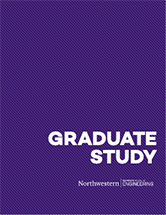Paving a Safer Road for Autonomous Vehicles
Bill Bi's work as a software engineer for autonomous vehicle startup Argo AI was honed during his time in Northwestern Engineering's Master of Science in Robotics (MSR) program.
Imagine driving up to a four-way intersection as three other cars arrive at the stop sign at the same time. Who goes first? Who has the right of way?
Now imagine you're not driving, but riding in an autonomous vehicle. How would the car handle that situation?
Those are some of the scenarios Xiaowei "Bill" Bi (MSR ‘21) ponders in his role as software engineer for autonomous vehicle startup Argo AI. For all the talk he's heard about driverless cars taking over roadways, Bi still sees a number of roadblocks.
“Many people are being overly optimistic about how soon the road is going to be full of autonomous vehicles,” Bi said. “The legislation and the process of building public trust has such a long way to go.”
Bi’s slow-and-steady approach is indicative of the culture at Argo AI. Its safety-first ethos is one of the things that attracted Bi to the company when he graduated from Northwestern Engineering's Master of Science in Robotics (MSR) program last year.
“Argo is more focused on replacing the drivers so that being on the road is safer, not only for the riders, but also for the pedestrians, bikers — anyone and anything on the road,” Bi said. “It is the one core value that every employee holds deep down.”
Bi’s interest in autonomous vehicle safety began as a college junior and helped shape his search for a master’s program as he looked to accelerate his career. The MSR program jumped out to him because of its depth and flexibility.
“When I went through the curriculum and the details of how the projects are arranged in MSR, I immediately saw a great opportunity for me to customize what kind of education I was going to receive,” he said.
Bi dove into his studies at Northwestern. He built a prototype of an advanced driver assistance system using a Jetson Nano computer that included deploying a deep neural network and computer vision algorithms for lane detection as his independent project. For his final project, which spanned the last two quarters of his time in the program, Bi focused on minimizing an autonomous vehicle’s stops and starts while merging onto a highway.
No surprise: Safety was the driving motivation behind Bi’s project choice.
“I reached pretty much all the milestones I set for the project,” he said. “I also got a great chance to work closely with several professors and prepared myself for interviews for positions that might require knowledge and experience with machine learning.”
One of those interviews was with Argo AI, which he joined in January. An early perk of the job was a ride in one of the company’s autonomous vehicles through the streets of Palo Alto, Calif. Bi was happy to see and feel that the car’s real-world responses matched the company’s mission and values.
“Most of the time, the car drives by itself just like how humans would drive it, making smooth accelerations, turns, and brakes,” Bi said. “But since Argo is so focused on safety, it takes some comparatively more cautious actions. To be honest, I might just guess it was someone in the driver seat who took the safety-driving class for the extra insurance discount, if I hadn’t known better.”
That brings Bi back to his view of how autonomous vehicles need to be rolled out to consumers – not as something novel, fun or efficient, but rather as something that one day will be demonstrably safer than human-controlled cars. That’s likely one of the only ways the public will end up adopting them as the norm, he said.
“The basic idea is that the cars would have to become so smart and so easy to drive that the public would then be willing to replace the human drivers,” he said. “When people get more familiar with such new technology, they will eventually trust it with their own lives and buy their own driverless cars.”


